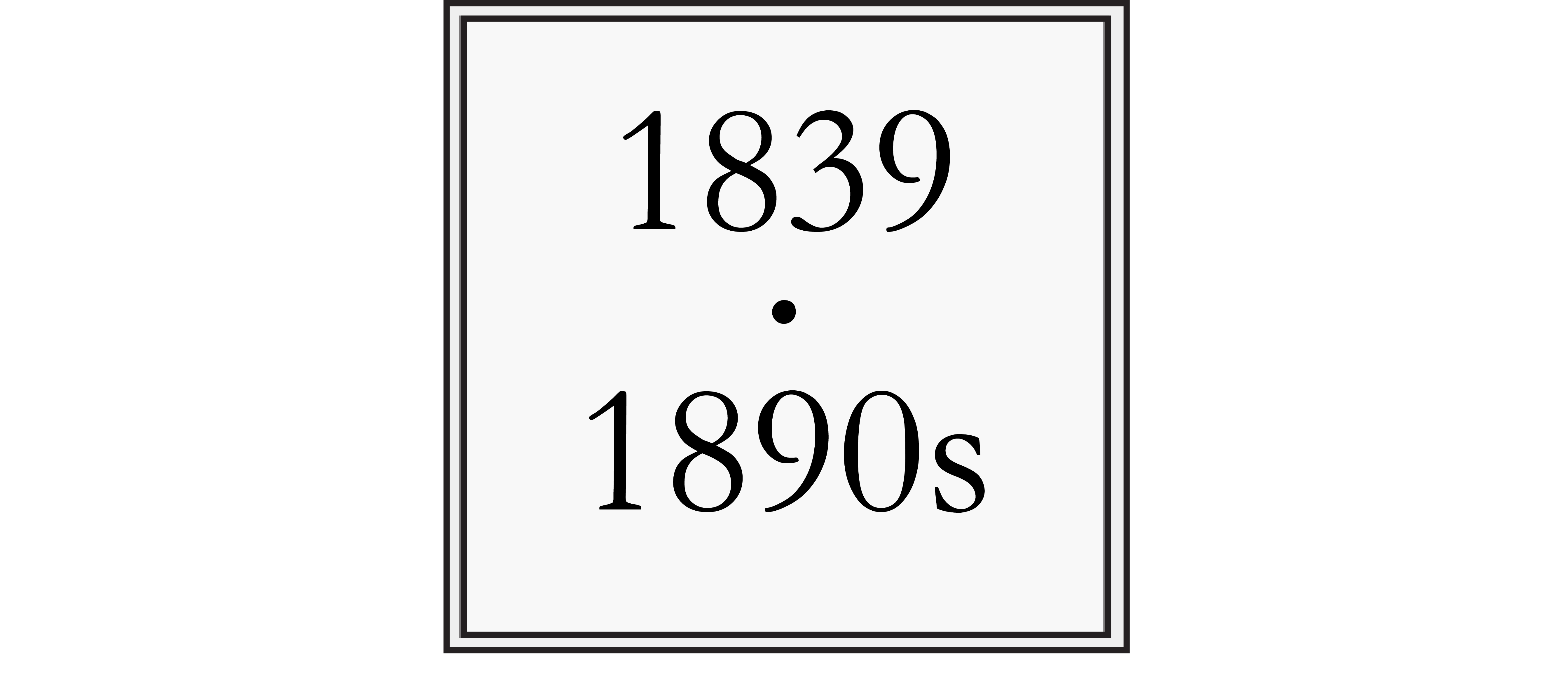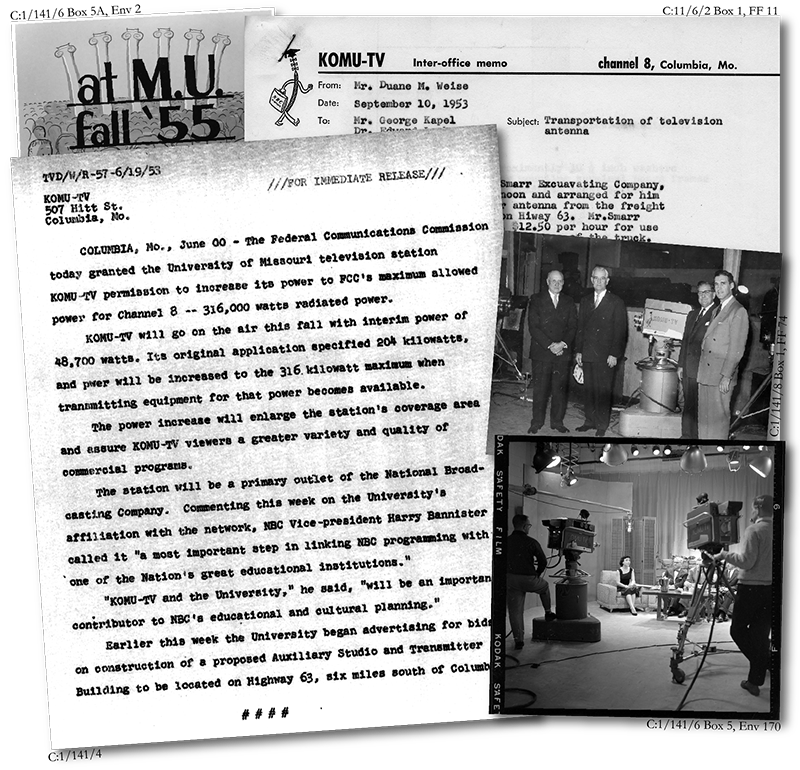
The University of Missouri brought television to Mid-Missouri with the first broadcast of KOMU-TV on December 21st, 1953. The station would soon air programming from the University in the areas of music, art, drama, and science, along with content from NBC, CBS, ABC and the DuMont Television Network. Weekday programming began at 4:15PM with station sign off at 10:45PM. Weekend broadcasts were extended to 11:00PM with programming on Sundays beginning at 1:00PM.
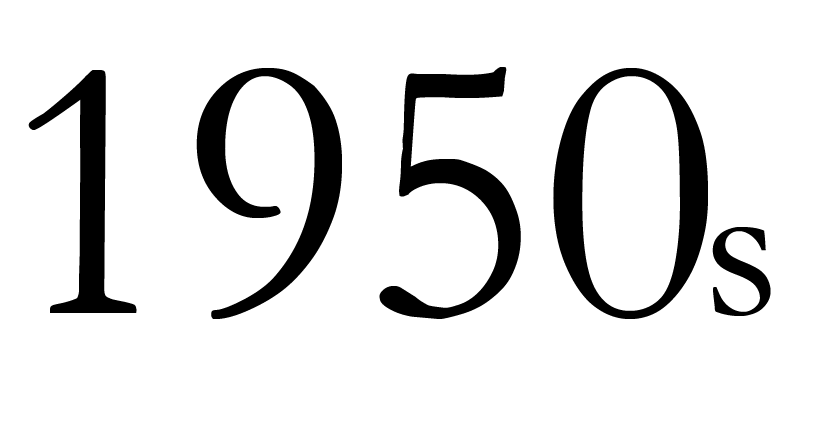 President Frederick Middlebush stands, with Governor Phil Donnelly, University Curator Lester Cox, and Director for Development and Operations Dr. Edward Lambert to his left, at the dedication of KOMU-TV on January 10th, 1954. Cox was instrumental in securing state government support and FCC approval for the University-owned commercial station.
President Frederick Middlebush stands, with Governor Phil Donnelly, University Curator Lester Cox, and Director for Development and Operations Dr. Edward Lambert to his left, at the dedication of KOMU-TV on January 10th, 1954. Cox was instrumental in securing state government support and FCC approval for the University-owned commercial station.
Showcase was an early production from the KOMU-TV studios that relied heavily on University faculty and staff to provide adult education and extension services to the citizens of Mid-Missouri. By 1955 kinescope recordings of Showcase were being sent to seven other stations for rebroadcast as The University of Missouri Half Hour.
Elmer Ellis began the decade as president of the University of Missouri and he retired in 1966 as president of the University of Missouri System, the central administration for the four campuses in Columbia, Rolla, Kansas City, and St. Louis. In 1963 the need for more public higher education opportunities in the two largest cities in Missouri found a response in the University of Kansas City's merger with the University of Missouri, the establishment of an undergraduate campus in St. Louis, and the elevation of Rolla's Missouri School of Mines from a division to a campus.
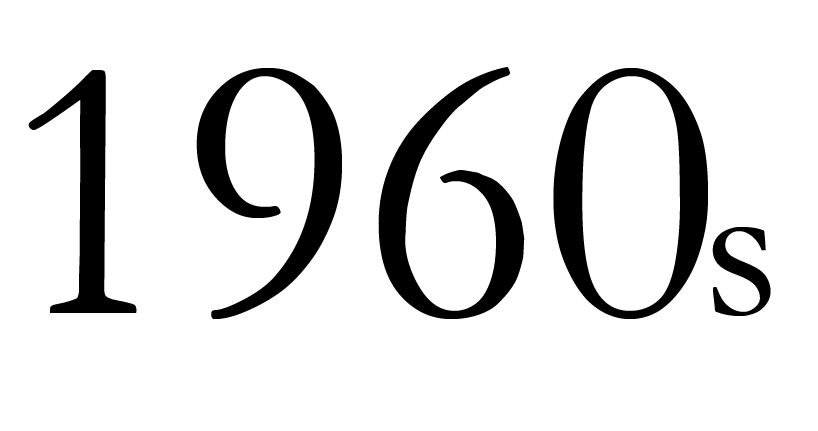 The note from UMKC Chancellor Carleton Scofield points up but one of the difficulties facing the University of Kansas City in its transition into the University of Missouri. Scofield would retire at the mandatory retirement age of 65 two years later.
The note from UMKC Chancellor Carleton Scofield points up but one of the difficulties facing the University of Kansas City in its transition into the University of Missouri. Scofield would retire at the mandatory retirement age of 65 two years later.
The University of Missouri had offered junior college instruction at the Normandy Residence Center in St. Louis prior to establishing the four-year campus there in 1963.
The photograph shows Ellis flanked by the campus chancellors: Merl Baker (Rolla), John Schwada (Columbia), James Bugg (St. Louis), and Randall Whaley, who replaced Scofield.
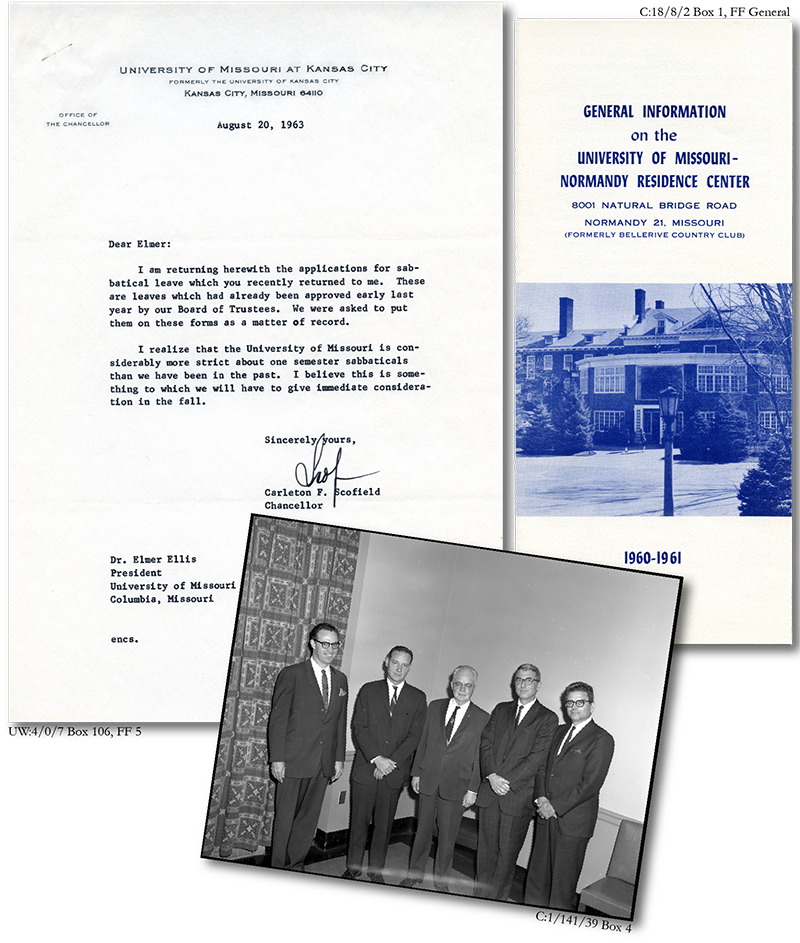
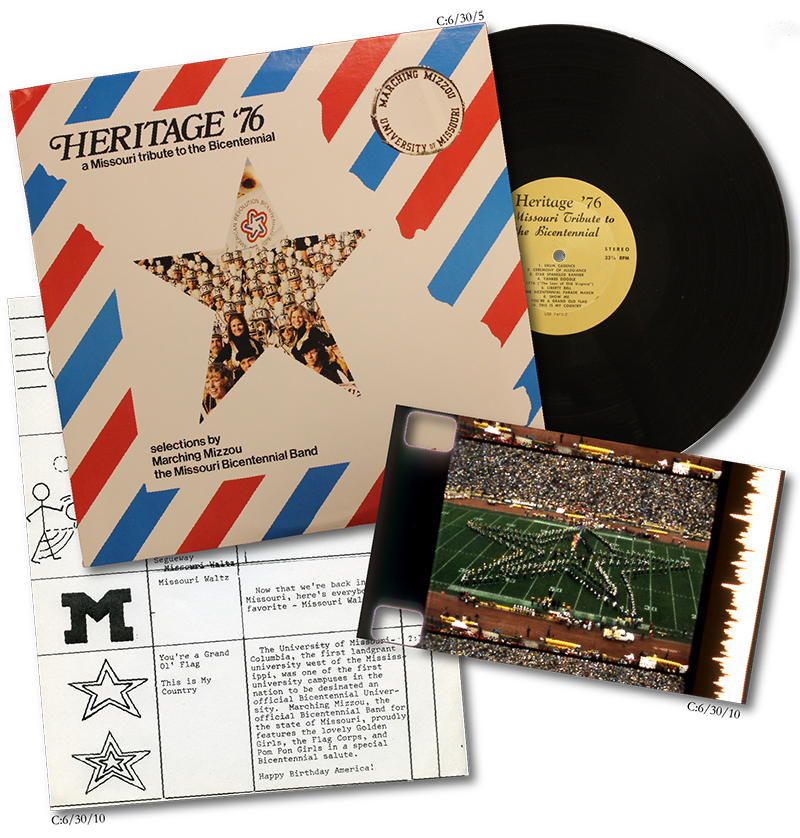
Marching bands have a long history at MU going back to the first brass band used by its military cadets in 1885. Over the years the military formation style of the band gave way to a show band style, and, by the time of its 1960 Orange Bowl appearance, the band was known as Marching Mizzou.
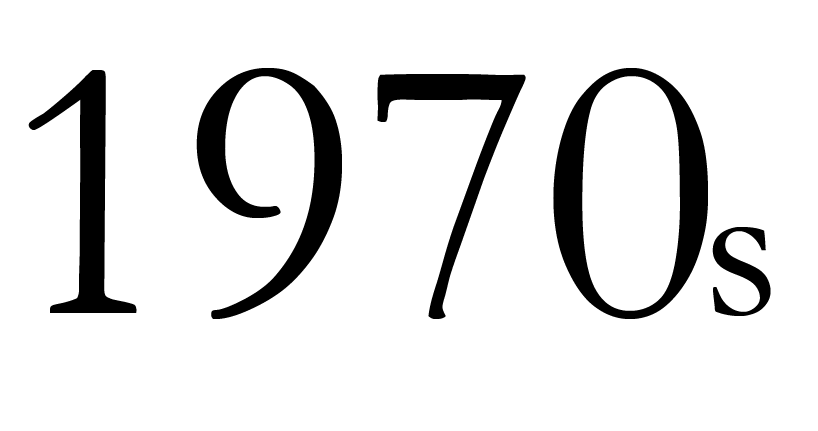 As the nation's bicentennial year drew near, Marching Mizzou was named the official State of Missouri Bicentennial Band. The University of Missouri was named a Bicentennial University by the American Revolution Bicentennial Administration later in 1974.
As the nation's bicentennial year drew near, Marching Mizzou was named the official State of Missouri Bicentennial Band. The University of Missouri was named a Bicentennial University by the American Revolution Bicentennial Administration later in 1974.
Marching Mizzou traveled to London, England, in the spring of 1975 for well-received performances at a number of soccer and rugby games. The trip received funding from the American Revolution Bicentennial Commission of Missouri, and the band raised additional support through the sale of its LP record "Heritage '76".
The band reprised some formations from London for the Nebraska game in the fall of 1975. A show book from that game outlines its "bicentennial salute," and a 16mm film frame shows the formation as it looked on the field that day in November.
The dome of Jesse Hall was first illuminated on October 1st, 1987, during the "Light the Way to 1989" ceremony that began the countdown for the celebration of the University's 150th anniversary. In addition to various events, exhibitions, lectures, and performances, funding was made available for faculty to research and write departmental histories.
The "Spirit of Mizzou - Moving On" tractor-trailer sits outside Crown Center in Kansas City for the St. Patrick's Day Parade. Exhibits about the University were built into the trailer, which made appearances throughout Missouri during 1989 to help communicate MU's mission of teaching, research, and service.
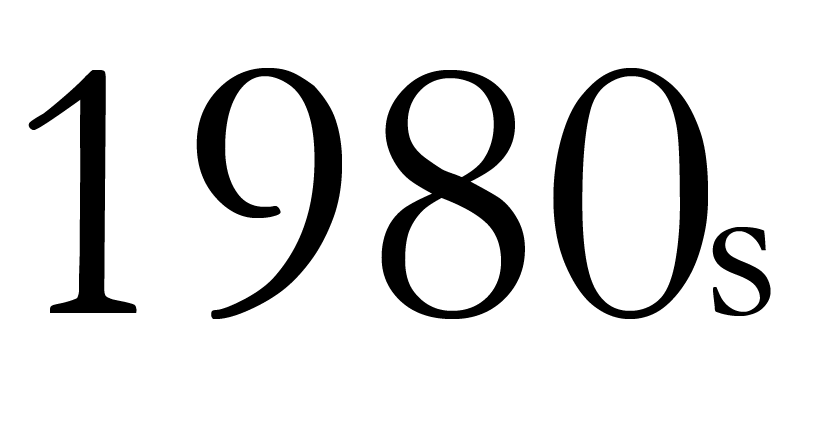 Columbia Mayor Rodney Smith (right) gives Chancellor Haskell Monroe a birthday card from the city.
Columbia Mayor Rodney Smith (right) gives Chancellor Haskell Monroe a birthday card from the city.
Roger Mitchell, Dean of Agriculture and Co-Chair of the Sesquicentennial Steering Committee, plants a Northern Red Oak south of Tate Hall on Arbor Day, April 7th, 1989. The tree marked the starting point of the 150-specimen Sesquicentennial Plant Trail.
A Sesquicentennial medallion was given to every 1989 graduate including the University's 200,000th degree recipient.
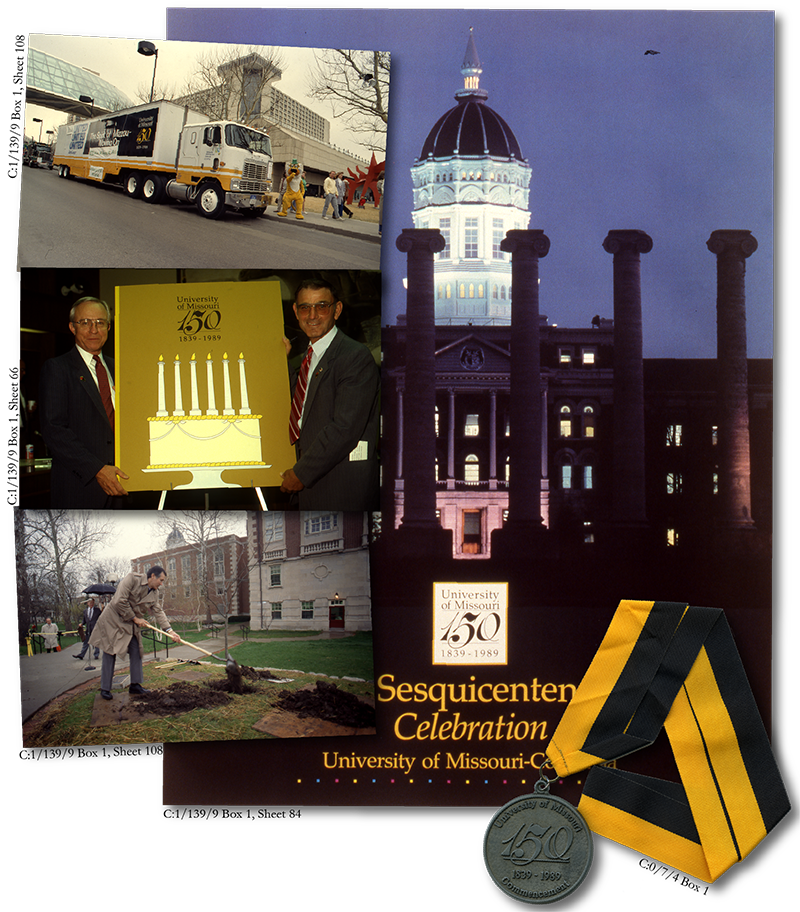
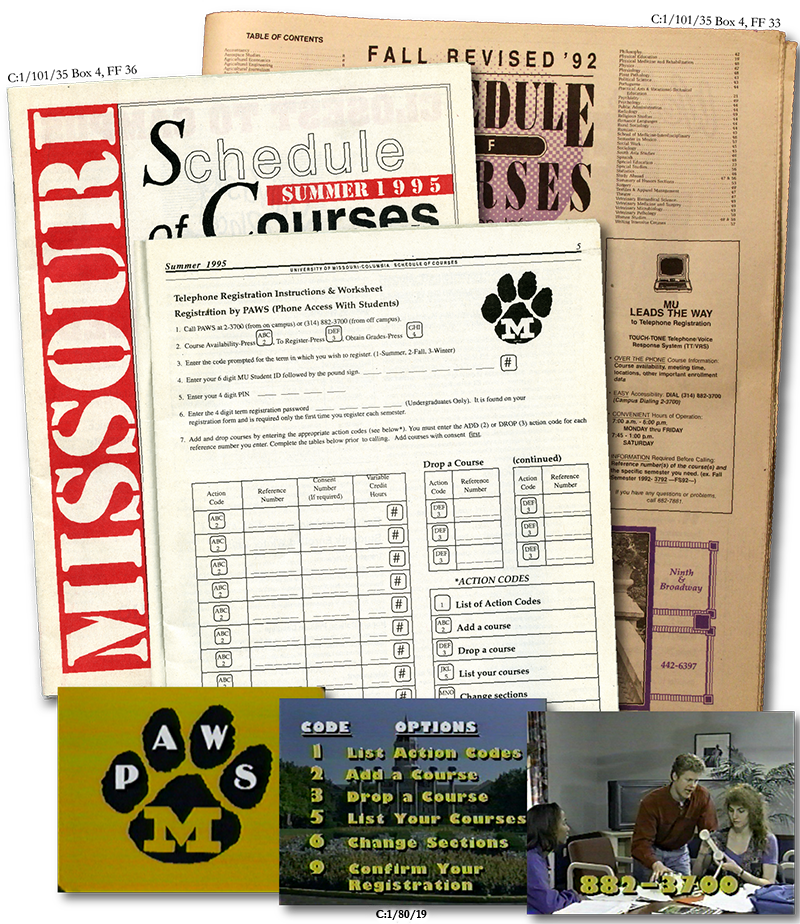
MU ventured further into the computer age in the 1980s with its implementation of an on-line registration system. For the MU campus the new system eliminated much student paperwork for pre-registration. Students were assigned a specific time slot to go to the student center (Brady Commons at that time) and have their class choices entered into the registration system by staff via computer terminals. The days of "course cards" were over.
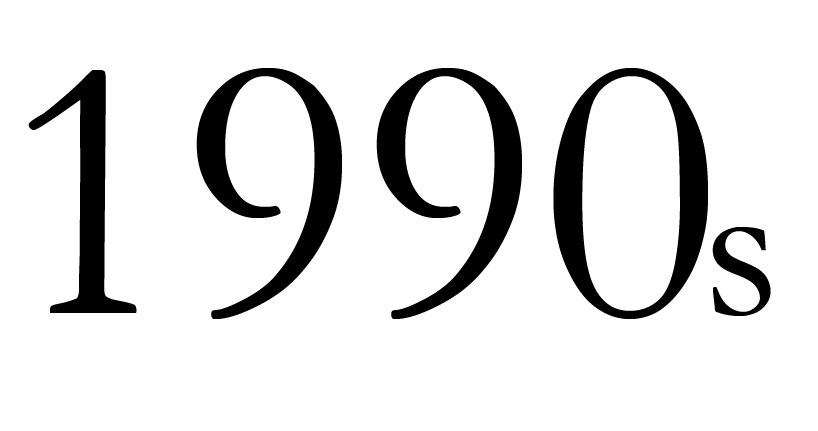 In 1992 the Touch-Tone Telephone/Voice Response System was introduced to provide information by phone on course availability and meeting times.
In 1992 the Touch-Tone Telephone/Voice Response System was introduced to provide information by phone on course availability and meeting times.
For Winter Semester 1994 the phone system, now called "Phone Access With Students" or PAWS, allowed registration with non-rotary phones, eliminating the need in many cases to go to Brady Commons to register. PAWS instructions were found in the front of each semester's Schedule of Courses.
The three video stills come from a mid-1990s MU publicity production for PAWS.
In 1997 registration was also possible through a computer connection to the STARMU system. STARMU would be replaced by MyZou in 2007.
In the 1980s there were calls in the College of Agriculture for a separate campus building dedicated to research, teaching, and outreach in Plant Sciences, similar to the campus's Animal Sciences Research Center. In 1997 partnerships between numerous Schools and Colleges combined with administrative support from MU Chancellor Richard Wallace to produce a construction plan for a Life Sciences Center.
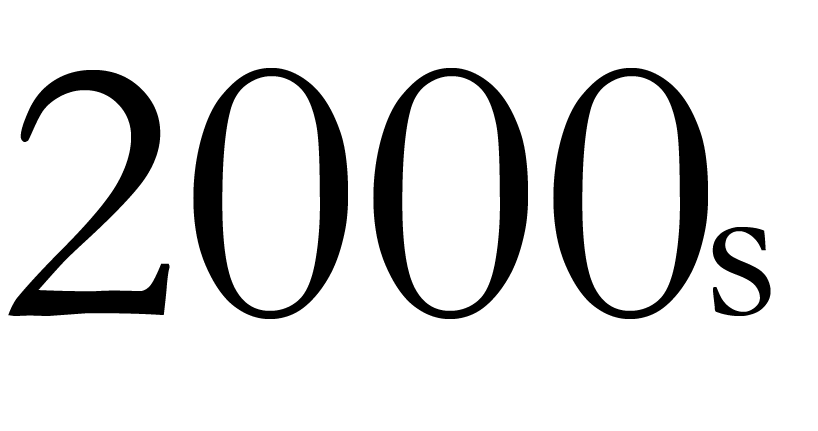 Ground was broken in 2001, the topping-off ceremony occurred in 2003, and the building was dedicated in 2004. A year later, the Center was named in honor of Missouri Senator Christopher "Kit" Bond, who helped secure federal funding for the building.
Ground was broken in 2001, the topping-off ceremony occurred in 2003, and the building was dedicated in 2004. A year later, the Center was named in honor of Missouri Senator Christopher "Kit" Bond, who helped secure federal funding for the building.
The photograph looks east across the first stages of the Center's construction in early 2002. Sanborn Field is in the left background.
The MU Art and Artifacts Committee chose the sculpture "Joy of Discovery" by the architectural glass artist Kenneth von Roenn for the building's atrium.
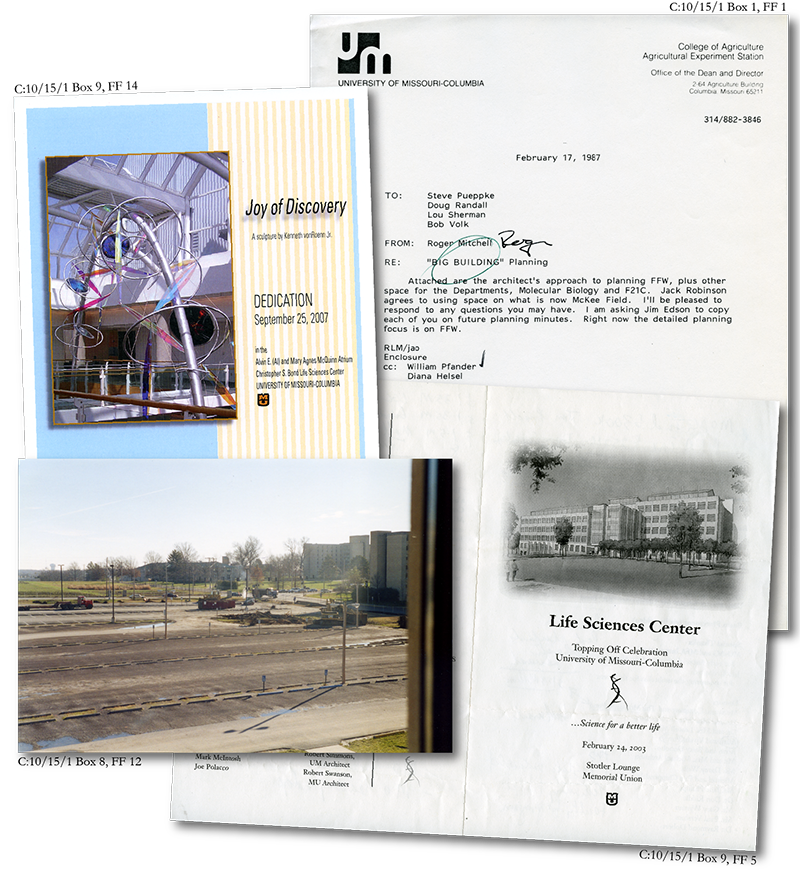
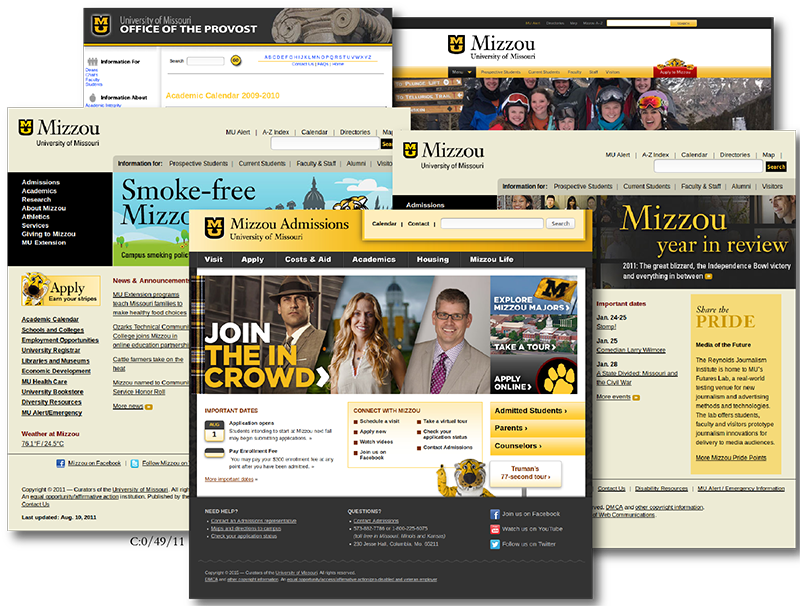
MU began developing its webpages in the mid-1990s, and the platform has since become an extensive source of information about nearly all aspects of the University. Many University publications, from newsletters to policy manuals, are now available through missouri.edu, and they often no longer have a paper counterpart. The M-Book, for example, which brought together in one publication various MU rules and regulations for students, became an online publication in 2000 and has now been incorporated into hyperlinks on the Office of Student Accountability and Support website.
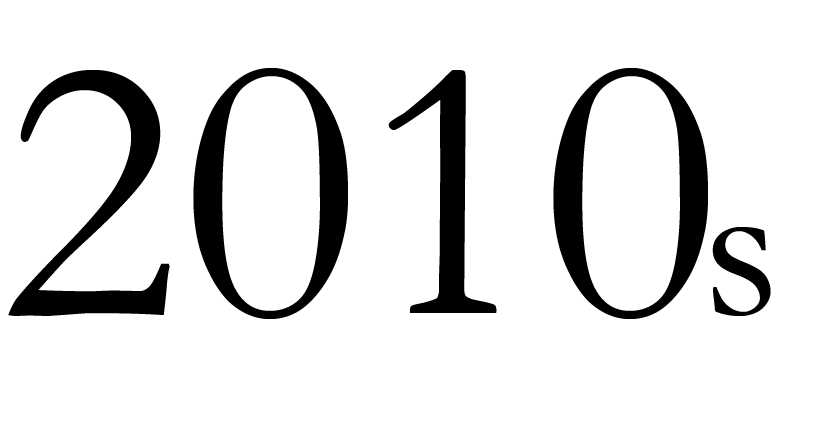 As information about academic departments, courses of study, graduation requirements, faculty, campus administration, research funding, events, campus parking, and more has moved to the University of Missouri's website, efforts have been made to capture much of that information for the collections of University Archives.
As information about academic departments, courses of study, graduation requirements, faculty, campus administration, research funding, events, campus parking, and more has moved to the University of Missouri's website, efforts have been made to capture much of that information for the collections of University Archives.
The screen captures from 2010-2019 give an indication not only of design changes from year to year, but also the various functions the website fulfills: everything from admissions, the official academic calendar, current events, and, ultimately, a part of the historical record.
